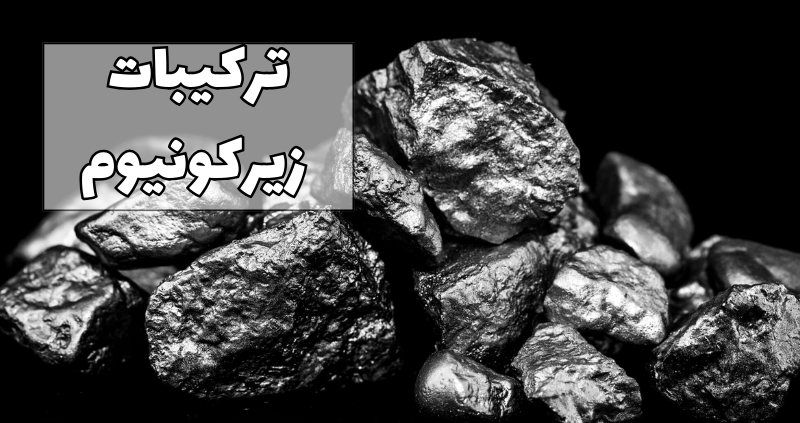
Zirconium, a multifaceted metal with amazing potential, plays a vital role in advanced industries. This wonderful element is present in thousands of everyday products; From luxury ceramics to heat resistant coatings. But the fact is that behind these diverse applications lies the complex and fascinating world of zirconium compounds. From advanced manufacturing methods to unique chemical properties, every aspect of this amazing element has a story to tell in this article. So join us to discover the secret of success of zirconium compounds.
Types of zirconium compounds and their applications
Zirconium, this multifaceted element, with its unique chemical structure, forms a wide range of compounds, each of which has its own applications. From shiny ceramics to scratch-resistant and heat-resistant coatings, these compounds play an important role in the development of various industries.
In the ceramic industry, zirconium compounds play a key role. Zircon (ZrSiO4), as an additive in the production of ceramics, gives them strength and heat resistance. Also, zirconium oxide (ZrO2) as a coating material improves the transparency and brilliance of ceramics. These compounds are widely used in the production of tiles, ceramic dishes, and other ceramic products.
Zirconium compounds also play an important role in the glass industry. Zirconium oxide, as an additive to glass, increases strength and heat resistance. These properties make glasses made with these compounds suitable for applications such as kitchenware and heat-resistant glass. Also, zirconium compounds are also used in the production of optical glasses.
Methods of producing zirconium compounds
The production of zirconium compounds is a complex and specialized process that requires advanced knowledge and technology. These compounds are produced in different ways, each of which has its own unique characteristics.
One of the most common production methods is the reduction process of zircon (ZrSiO4). In this method, zircon is first decomposed with strong acids such as sulfuric or hydrochloric acid, and then zirconia (ZrO2) is extracted using other chemicals. This material is used as a raw material to produce other zirconium compounds such as zirconium nitride (ZrN) or zirconium carbide (ZrC).
Another method, the production of zirconium compounds through Powder metallurgy Is. In this method, zirconium metal powder is placed in special chambers along with other raw materials, and the desired compounds are produced during thermal and pressure processes. This method is especially useful for the production of more complex compounds such as zirconia-reinforced ceramics.
Physical and chemical properties of zirconium compounds
Zirconium compounds, thanks to the unique chemical structure of the zirconium element, have unique physical and chemical properties that have made them very valuable materials in various industries. These features have greatly expanded the scope of application of these compounds.
Physically, zirconium compounds usually have high hardness and strength, very good corrosion and erosion resistance, and very high melting and boiling points. These properties are widely used, especially in industries that require materials resistant to harsh conditions, such as ceramics and thermal coatings. Also, some zirconium compounds, such as zirconium (ZrSiO4) and zirconia (ZrO2), have remarkable clarity and luster that make them popular choices in the glass industry.
Chemically, zirconium compounds are stable in most acidic and alkaline environments and show high resistance to corrosion. This feature, along with high thermal resistance, has caused these compounds to be used as protective coatings against harsh environmental conditions. Also, some zirconium compounds, such as ZrN and ZrC, have hardening and wear properties.
Challenges and limitations of using zirconium compounds
Despite the extraordinary properties of zirconium compounds, the use of these materials is associated with some challenges and limitations. Knowing these obstacles can help to improve and develop future applications of these compounds.
One of the most important challenges in using zirconium compounds is the relatively high price of these materials. Complex production processes and high energy consumption have increased production costs and limited the availability of these compounds for some industries and applications. This has caused researchers to look for more efficient and less expensive production methods.
In addition, in some sensitive applications such as nuclear industries, the use of zirconium compounds has limitations. These materials have relatively high absorption properties of neutrons, which can be problematic in some specific applications. This limitation has led researchers to develop more suitable alternatives.
Know more: strontium
final word
Zirconium compounds, like a hidden treasure in the world of advanced materials, have amazing power and potential. From brilliant ceramics to heat-resistant coatings, these compounds play a key role in the advancement of various technologies. Although there are challenges and limitations in the way of using these materials, scientists and engineers have tried to overcome these obstacles with their creativity and innovation. The future of zirconium compounds is full of transformative promises, and we will soon see new applications of these material wizards.
